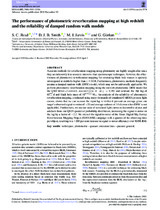| dc.contributor.author | Read, S C | |
| dc.contributor.author | Smith, D J B | |
| dc.contributor.author | Gürkan, G | |
| dc.contributor.author | Jarvis, M J | |
| dc.date.accessioned | 2021-02-10T10:18:11Z | |
| dc.date.available | 2021-02-10T10:18:11Z | |
| dc.date.issued | 2020-03 | |
| dc.identifier.citation | Read,S.C (2020).The performance of photometric reverberation mapping at high redshift and the reliability of damped random walk models.Monthly Notices of the Royal Astronomical Society V492.I3. Pg 3940–3959. DOI:https://doi.org/10.1093/mnras/stz3574 | en_US |
| dc.identifier.other | DOI:https://doi.org/10.1093/mnras/stz3574 | |
| dc.identifier.uri | http://hdl.handle.net/10566/5883 | |
| dc.description.abstract | Accurate methods for reverberation mapping using photometry are highly sought after since they are inherently less resource intensive than spectroscopic techniques. However, the effectiveness of photometric reverberation mapping for estimating black hole masses is sparsely investigated at redshifts higher than z ≈ 0.04. Furthermore, photometric methods frequently assume a damped random walk (DRW) model, which may not be universally applicable. We perform photometric reverberation mapping using the JAVELIN photometric DRW model for the QSO SDSS-J144645.44+625304.0 at z = 0.351 and estimate the Hβ lag of 65+6−1 d and black hole mass of 108.22+0.13−0.15M⊙. An analysis of the reliability of photometric reverberation mapping, conducted using many thousands of simulated CARMA process light curves, shows that we can recover the input lag to within 6 per cent on average given our target’s observed signal-to-noise of >20 and average cadence of 14 d (even when DRW is not applicable). Furthermore, we use our suite of simulated light curves to deconvolve aliases and artefacts from our QSO’s posterior probability distribution, increasing the signal-to-noise on the lag by a factor of ∼2.2. We exceed the signal-to-noise of the Sloan Digital Sky Survey Reverberation Mapping Project (SDSS-RM) campaign with a quarter of the observing time per object, resulting in a ∼200 per cent increase in signal-to-noise efficiency over SDSS-RM. | en_US |
| dc.language.iso | en | en_US |
| dc.publisher | Oxford University Press | en_US |
| dc.subject | Techniques: Photometric | en_US |
| dc.subject | Quasars: Emission lines | en_US |
| dc.subject | Quasars: General | en_US |
| dc.title | The performance of photometric reverberation mapping at high redshift and the reliability of damped random walk models | en_US |
| dc.type | Article | en_US |

